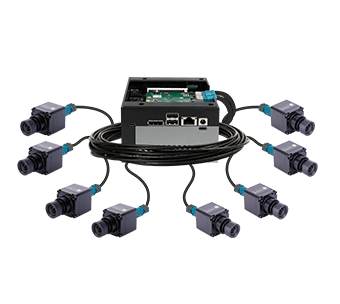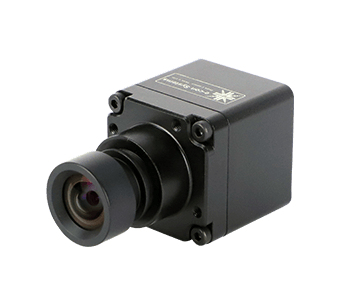In the past, the selection criteria for cameras predominantly focused on resolution, sensitivity, and frame rate. However, High Dynamic Range (HDR) technology has emerged as a key catalyst, especially for embedded vision systems that operate in environments that face challenging and varying lighting conditions.
HDR technology enhances the ability to capture images across light intensities, from very dark to very bright, without losing detail in either extremity. It is useful for scenarios where light conditions can change rapidly or where capturing details in both brightly illuminated and shadowed areas is crucial.
In this blog, you’ll discover expert insights about HDR technology, why it’s important, how HDR cameras work, and their popular use cases.
What Is High Dynamic Range (HDR) and Why Is It Crucial?
In a nutshell, the term “dynamic range” refers to the total amount of light that is captured from a particular scene. When a captured image contains a lot of bright zones along with numerous shadowy or dimly lit areas, the scene can be described as having HDR capabilities.
As you may be aware, many modern embedded vision systems require images captured with optimal exposure time. It ensures that brightly lit areas are not excessively illuminated while the darker regions remain adequately visible.
Otherwise, the spectral range in a scene will exceed the camera’s dynamic range. So, the object captured will be washed out to white in the output image, and the dark areas in the scene will appear darker.
How Do HDR Cameras Work?
Typically, an HDR image is produced by taking three separate images of the same scene at varying shutter speeds. This method captures one image with low exposure, one with medium exposure, and one with high exposure, each reflecting different levels of light exposure through the lens.
These varying exposures are then processed by the image sensor, which merges them to form a complete image. This technique mimics the dynamic range of the human eye, effectively replicating what we naturally perceive.
The process involves merging these multiple exposures into a single image and fine-tuning the contrast levels using consistent aperture and shutter settings, culminating in the creation of an HDR image.
Read: What are the most effective methods to achieve High Dynamic Range imaging?
When to Use HDR Cameras
HDR camera for bright-light conditions
Conventional cameras often struggle in bright indoor and outdoor lighting conditions, producing overexposed images with fine details lost due to the high levels of light saturation.
HDR cameras, however, can manage such scenarios. They ensure that the final image reproduces the scene with high accuracy, capturing details that would typically be washed out in normal mode.

HDR camera for low-light conditions
Conversely, in low-light environments, standard cameras tend to capture images that are overly dark, resulting in unclear details. HDR technology addresses the issue, enhancing the visibility of the scene by increasing the available amount of light and reducing noise.

Hence, HDR cameras allow for the production of clearer, more detailed images, even in dim conditions.
Read: Why 4K HDR cameras with large pixel size for outdoor vision applications?
Popular applications of HDR cameras
1) Autonomous Mobile Robots (AMRs)
Autonomous Mobile Robots (AMRs) operate in a range of environments, from dim warehouses to brightly lit outdoor spaces, which tend to challenge conventional cameras. HDR cameras equip these robots with the ability to capture fine details in dark or overly bright areas.
Since AMRs perform tasks such as material handling and delivery, the improved visual data helps AMRs avoid obstacles and navigate complex paths. It ensures reliable task execution while optimizing key workflows and increasing productivity in daily operations.
2) Autonomous Guided Vehicles (AGVs)
Similar to AMRs, Autonomous Guided Vehicles (AGVs) are also under constant pressure to carefully navigate spaces with varied lighting, from dim corners to brightly lit areas. HDR cameras enhance their navigation capabilities by delivering superior visual data.
It makes sure that AGVs operate smoothly without compromising on safety or efficiency, which can be a game-changer for use cases where consistency is tremendously important.
3) Smart trolley and smart checkout systems
Smart trolleys and checkout systems in retail environments often face challenges with changing lighting conditions which can affect business-critical retail workflows like product identification. Integrating HDR cameras into these systems helps capture high-quality images that can lead to streamlined retail operations while minimizing errors and improving customer satisfaction.
Also, HDR cameras can help in inventory management by providing clear images that assist in stock verification and management tasks.
4) Automated sports broadcasting systems
Automated sports broadcasting systems leverage HDR cameras to capture high-quality footage across lighting conditions, from bright daylight to stadium lights at night. They ensure that all aspects of the game are captured effectively, thereby delivering superior viewer experiences.
The improved image quality also supports advanced analytics and replay features, adding value to broadcasts and engaging audiences at a deeper level.
5) Smart traffic management systems
Smart traffic management systems rely on HDR cameras to monitor and manage road conditions. At intersections and on highways, where lighting conditions can change abruptly, the usage of HDR cameras can be a make-or-break moment. They provide clear images that enable accurate vehicle detection, traffic flow analysis, and incident response.
They are crucial for developing responsive traffic control measures that adapt to real-time conditions, increasing road safety and reducing congestion.
6) Smart parking management systems
HDR cameras improve the functionality of smart parking management systems by providing clear images in different lighting conditions. It helps detect empty parking spots and identify vehicles. HDR technology, basically, delivers clear images that, in turn, help drivers find parking faster.
Furthermore, these cameras support security measures by monitoring for improper parking and unauthorized access.
7) Biometric systems
HDR cameras play a major role in biometric systems, such as facial recognition technologies. They capture detailed images that boost the system’s ability to accurately identify individuals, even in suboptimal lighting conditions. It improves security protocols, especially in areas requiring stringent access control.
HDR cameras also support integrating biometric data with other security measures, creating a stronger security ecosystem overall.
Read: Why are HDR cameras important – and what are their major embedded vision use cases?
Read: What makes e-con Systems’ 4K HDR camera module a perfect choice for optical microscopy?
Benefits of HDR Cameras
Let’s quickly recap the major benefits of HDR cameras based on the above information.
- Enhanced dynamic range: HDR cameras can capture a wider spectrum of light intensities, handling scenes with high contrast between the brightest and darkest areas.
- Consistent imaging performance: HDR cameras provide consistent image quality, maintaining clarity and detail whether the setting is brightly lit or shrouded in darkness.
- Improved detail visibility: By combining multiple exposures into a single image, HDR cameras can reveal details that are obscured in standard cameras under extreme lighting conditions.
- Reduced image processing: With HDR cameras, the need for post-processing to correct exposure and balance contrasts is minimized – reducing the computational load on systems.
Read: Why you need a 4K HDR camera with dual streaming for video conferencing
e-con Systems offers State-of-the-Art HDR Cameras
e-con Systems has been designing, developing and manufacturing custom and off-the-shelf cameras since 2003. We have proven experience in successfully delivering cutting-edge camera solutions, no matter the industry, from retail and healthcare to sports broadcasting, smart city, smart agriculture, surveillance, and more.
Read: e-con Systems launches New Rugged PoE HDR Camera
Our customization support runs deep, offering ISP fine-tuning, lens gluing/alignment, etc. e-con Systems’ HDR camera portfolio is also massive, catering to all popular embedded vision use cases.
HDR USB cameras
- See3CAM_CU31 – Sony® ISX031 3MP 120dB HDR USB Camera
- See3CAM_CU81 – AR0821 4K HDR USB Camera With 1/2″ Sensor
- e-CAM83_USB – 4K High-Resolution HDR USB Camera Based on Sony IMX317
- See3CAM_CU20 – Full HD HDR USB3.1 Gen1 Camera
- See3CAM_CU22 – Full HD HDR USB Camera with LFM
- Hyperyon® – 2MP Sony STARVIS IMX290 Ultra Low-Light USB Camera
HDR camera modules
- Sony ISX031 Camera Module
- e-CAM82_CUMI0821_MOD – 8MP (4K) HDR MIPI Camera Module
- e-CAM27_CUMI290_MOD – 2MP IMX290 Camera Module
- e-CAM20_CU0230_MOD – 2MP Industrial-Grade HDR Camera Module
NVIDIA-based HDR cameras
- e-CAM81_CUNX – 8MP HDR Camera for NVIDIA Jetson Xavier NX/TX2 NX/Nano
- STURDeCAM31_CUOAGX – 3MP 120dB HDR NVIDIA® Jetson Orin™ Camera for Autonomous Mobility
- e-CAM31_CUOAGX – Sony ISX031 120dB HDR Camera for NVIDIA® Jetson AGX Orin™
- NileCAM21_CUXVR – HDR GMSL2 Multi-Camera Solution for NVIDIA Jetson AGX Xavier
- e-CAM20_CUXVR – Sony STARVIS IMX290 Synchronized HDR Multi-Camera System
- SmarteCAM – IP66-Rated AI HDR Smart Camera
GMSL2 HDR cameras
- STURDeCAM31 – IP69K Automotive-Grade GMSL2 HDR Camera with LFM
- STURDeCAM20 – IP67-Rated Full HD GMSL2 HDR Camera Module
- NileCAM21 – Full HDR GMSL2 HDR Camera Module with LFM
Smart HDR cameras
Check out our HDR camera page or explore our Camera Selector page to see the complete entire camera portfolio.
If you require any help integrating HDR cameras into your embedded vision products, please write to camerasolutions@e-consystems.com.




